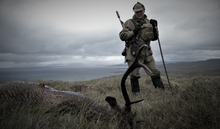
Deer stalking, or simply stalking, is a British term for the stealthy pursuit of deer on foot to hunt for venison, leisure, trophy, or to control their numbers as part of wildlife management, just as with rabbiting and boar hunting. Deer hunted in the UK are red deer, roe deer, fallow deer, sika deer, muntjac, water deer, and hybrids of these deers.
Stalked deer are commonly shot with a bolt action rifle. This may take on moors, or in woodland. Controls provided by the Game Act apply to deer (from the Deer Act 1991). Venison is also a highly popular meat with sales quadrupling in the UK in 2014. Prior to the invention of the centerfire ammunition, deer were stalked with the aid of a sighthound, like the Scottish Deerhound. Bowhunting is illegal in the United Kingdom for all animals.
The term deer hunting is used in North America to describe the hunting strategy of deer without using hunting dogs, but in Britain and Ireland, the term generally refers to the pursuit of deer with scent hounds and unarmed pursuers, typically on horseback. The hunter is called a game stalker.
Background

Stalking is defined as pursuing or approaching stealthily, which is often necessary when approaching wild deer or the high seat overseeing the area where the deer are likely to be passing. Scottish deer stalking is often done under the guidance of a professional stalker or a resident expert.
Apart from the stalking of Red and Sika deer on the open hillsides of Scotland and the Lake District, which takes place in daylight, most deer stalking takes place in the first and last two hours of daylight. The only English county without any wild deer is Middlesex, and in all other English and Scottish counties, as well as most Welsh counties, there are deer populations controlled by deer stalking.
For trophy hunting, antlers are measured by one of several scoring systems used to compare the relative merits of the heads. In Europe, including the UK, the Conseil International du Chasse (CIC) system is used; in America, it is either the Boone & Crockett or the Safari Club International (SCI), and in Australia, it is the Douglas system.
Purpose

There are no natural predators of deer in Britain. Therefore, to maintain a stable population of deer, a cull of some of them is performed each year. Yearly, the deer population is counted to determine the age and sex profile of those to be culled. Barren, genetically odd or very old animals, are then killed during the correct deer season. This selection results in a pyramid profile with a few healthy older animals of each sex at the top and increasing numbers of each sex down to the yearlings at the bottom.
The males with outstanding antlers are sometimes referred to as trophy animals and, as part of the cull, can be shot as part of a purchased sporting package to bring income to help with the management of the deer population as a whole. If population reduction is required, more females will be culled. If a population increase is required, only a select few will be culled.
There are many scenarios that prevent a shot from being taken, such as no safe backstop, no clear shot, the deer does not stop, there are other deer behind the chosen deer, the deer which is visible is out of season, it is not an appropriate animal to cull, or it is a trophy animal which could bring in much-needed funds. As such, not every stalk results in a killed deer.
References
- Whitehurst, Frederick Feild (1882). "Chapter VIII". On the Grampian hills. Grouse and ptarmigan shooting, deer stalking, salmon and trout fishing. London: Tinsley Brothers. p. 64. Retrieved 13 July 2019.
- "Shooting seasons". BASC. Retrieved 27 October 2024.
- "Venison sales quadruple - Shooting UK". shootinguk.co.uk. 25 July 2014. Retrieved 12 April 2018.
- Scrope, William. The Art of Deer-stalking. London: John Murray 1839.
- MacRae, Alexander, A Handbook of Deer-stalking (1880)
- ^ Brander, Michael (1986). Deer stalking in Britain. London: Sportsman's Press. ISBN 978-0-948253-05-8.
- ^ Hart-Davis, Duff (1978). Monarchs of the glen: a history of deer-stalking in the Scottish highlands. London: J. Cape. ISBN 978-0-224-01463-2.
- Fears, J. Wayne (2015). Deer hunter's & land manager's pocket reference: a database for hunters and rural landowners interested in deer management. New York, NY: Skyhorse Publishing. ISBN 978-1-63220-590-2.
- "Cull planning" (PDF). thedeerinitiative.co.uk. 2009. Archived (PDF) from the original on 8 December 2015. Retrieved 2 November 2020.
- Alcock, I. C. N. (1996). Stalking deer in Great Britain (Repr ed.). Shrewsbury: Swan Hill. ISBN 978-1-85310-250-9.